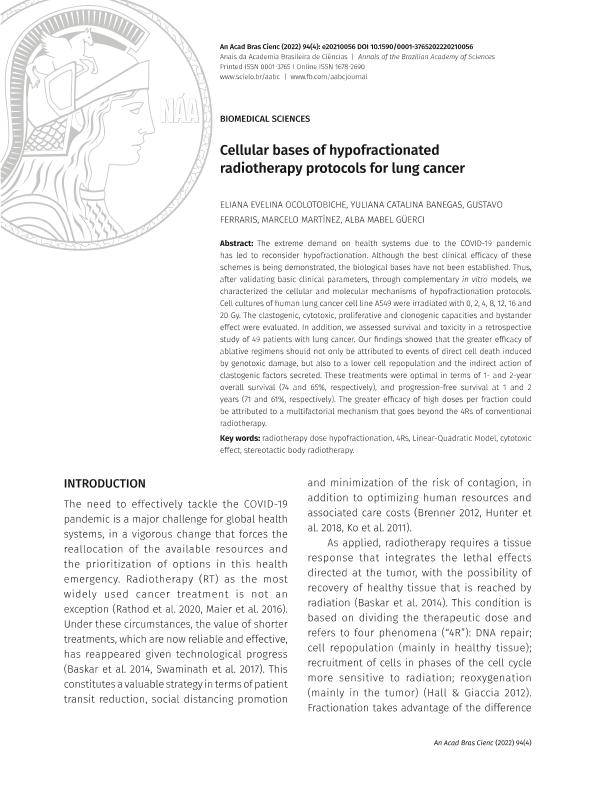Artículo
Cellular bases of hypofractionated radiotherapy protocols for lung cancer
Ocolotobiche, Eliana Evelina ; Banegas, Yuliana Catalina; Ferraris, Gustavo Nestor; Martínez, Marcelo; Güerci, Alba Mabel
; Banegas, Yuliana Catalina; Ferraris, Gustavo Nestor; Martínez, Marcelo; Güerci, Alba Mabel
 ; Banegas, Yuliana Catalina; Ferraris, Gustavo Nestor; Martínez, Marcelo; Güerci, Alba Mabel
; Banegas, Yuliana Catalina; Ferraris, Gustavo Nestor; Martínez, Marcelo; Güerci, Alba Mabel
Fecha de publicación:
07/2022
Editorial:
NLM (Medline)
Revista:
Anais da Academia Brasileira de Ciencias
ISSN:
1678-2690
Idioma:
Inglés
Tipo de recurso:
Artículo publicado
Clasificación temática:
Resumen
The extreme demand on health systems due to the COVID-19 pandemic has led to reconsider hypofractionation. Although the best clinical efficacy of these schemes is being demonstrated, the biological bases have not been established. Thus, after validating basic clinical parameters, through complementary in vitro models, we characterized the cellular and molecular mechanisms of hypofractionation protocols. Cell cultures of human lung cancer cell line A549 were irradiated with 0, 2, 4, 8, 12, 16 and 20 Gy. The clastogenic, cytotoxic, proliferative and clonogenic capacities and bystander effect were evaluated. In addition, we assessed survival and toxicity in a retrospective study of 49 patients with lung cancer. Our findings showed that the greater efficacy of ablative regimens should not only be attributed to events of direct cell death induced by genotoxic damage, but also to a lower cell repopulation and the indirect action of clastogenic factors secreted. These treatments were optimal in terms of 1- and 2-year overall survival (74 and 65%, respectively), and progression-free survival at 1 and 2 years (71 and 61%, respectively). The greater efficacy of high doses per fraction could be attributed to a multifactorial mechanism that goes beyond the 4Rs of conventional radiotherapy.
Archivos asociados
Licencia
Identificadores
Colecciones
Articulos(IGEVET)
Articulos de INST.DE GENETICA VET ING FERNANDO NOEL DULOUT
Articulos de INST.DE GENETICA VET ING FERNANDO NOEL DULOUT
Citación
Ocolotobiche, Eliana Evelina; Banegas, Yuliana Catalina; Ferraris, Gustavo Nestor; Martínez, Marcelo; Güerci, Alba Mabel; Cellular bases of hypofractionated radiotherapy protocols for lung cancer; NLM (Medline); Anais da Academia Brasileira de Ciencias; 94; 4; 7-2022; 1-13
Compartir
Altmétricas



